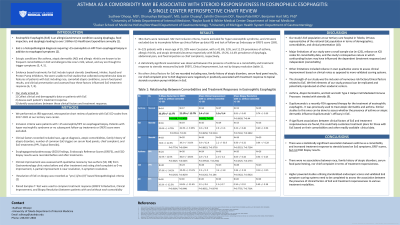Tuesday Poster Session
Category: Esophagus
P3280 - The Presence of Asthma May Be Associated with Treatment Responsiveness to Steroids in Eosinophilic Esophagitis: A Single Center Retrospective Chart Review
Tuesday, October 24, 2023
10:30 AM - 4:00 PM PT
Location: Exhibit Hall

Has Audio

Sudheer Dhoop, MD
University of Toledo
Toledo, OH
Presenting Author(s)
Sudheer Dhoop, MD1, Dhanushya Battepati, MD1, Justin Chuang, MD1, Sahithi Chinnam, DO1, Rayna Patel, MD1, Benjamin R. Hart, MD, PhD, MPH2
1University of Toledo, Toledo, OH; 2University of Michigan, Grosse Ile, MI
Introduction: Eosinophilic Esophagitis (EoE) is an allergic disorder causing significant morbidity in the U.S. requiring >15 eosinophils/HPF on esophageal biopsy for diagnosis. Ectopic conditions like asthma and allergic rhinitis are known to be frequent comorbidities in EoE and allergens like cow’s milk, wheat, and soy are thought to trigger symptoms. Our study’s purpose is to find significant associations between these clinical factors and treatment responsiveness to EoE.
Methods: We performed an IRB-approved, retrospective chart review of patients with EoE ICD-codes from 2017-2021 at our tertiary care center. Inclusion criteria were patients with >15 eosinophils/HPF on esophageal biopsy. Patients with hyper eosinophilic syndrome or no subsequent follow-up data were excluded. Clinical factors recorded included race, age at diagnosis, personal and family history of atopic disorders, number of common EoE triggers on serum food panels, chief complaint, and EoE treatments. Endoscopic Reference Scores (EREFS) on initial and subsequent EGD, and “Clinical Improvement” 1-4 (No, Minimal, Significant, Resolution) were recorded. EREF % improvement and Clinical Improvement associations were calculated with two sample Student’s T-tests. Resolution of EoE on biopsy was recorded as “yes or no” and association with clinical factors was calculated with two sample Student's T-Test.
Results: 281 charts were reviewed. 242 met inclusion criteria, 3 were excluded for hyper eosinophilic syndrome, and 114 were excluded due to incomplete follow-up data. N=125 patients with a mean age of 35, 92% were Caucasian, with a 41.6%, 32%, and 11.2% prevalence of asthma, allergic rhinitis, and atopic dermatitis/eczema respectively with 56.8%, 19.2%, 14.4% prevalence of dysphagia, abdominal pain, and food impaction as chief complaints respectively. A statistically significant association was observed between the presence of asthma and treatment response to steroids measured by both EREFS, Clinical Improvement, but not by biopsy resolution (table 1). No other associations were statistically significant.
Discussion: Our results suggest that topical corticosteroids and PPIs may be associated with a higher treatment response of EoE in patients with asthma relative to non-asthmatics. Major limitations to our study were bias introduced from retrospective chart review, limited sample size, and limitation to one center. More robust studies can explore these associations and develop models to recommend initial therapy for individual patients.
Disclosures:
Sudheer Dhoop, MD1, Dhanushya Battepati, MD1, Justin Chuang, MD1, Sahithi Chinnam, DO1, Rayna Patel, MD1, Benjamin R. Hart, MD, PhD, MPH2. P3280 - The Presence of Asthma May Be Associated with Treatment Responsiveness to Steroids in Eosinophilic Esophagitis: A Single Center Retrospective Chart Review, ACG 2023 Annual Scientific Meeting Abstracts. Vancouver, BC, Canada: American College of Gastroenterology.
1University of Toledo, Toledo, OH; 2University of Michigan, Grosse Ile, MI
Introduction: Eosinophilic Esophagitis (EoE) is an allergic disorder causing significant morbidity in the U.S. requiring >15 eosinophils/HPF on esophageal biopsy for diagnosis. Ectopic conditions like asthma and allergic rhinitis are known to be frequent comorbidities in EoE and allergens like cow’s milk, wheat, and soy are thought to trigger symptoms. Our study’s purpose is to find significant associations between these clinical factors and treatment responsiveness to EoE.
Methods: We performed an IRB-approved, retrospective chart review of patients with EoE ICD-codes from 2017-2021 at our tertiary care center. Inclusion criteria were patients with >15 eosinophils/HPF on esophageal biopsy. Patients with hyper eosinophilic syndrome or no subsequent follow-up data were excluded. Clinical factors recorded included race, age at diagnosis, personal and family history of atopic disorders, number of common EoE triggers on serum food panels, chief complaint, and EoE treatments. Endoscopic Reference Scores (EREFS) on initial and subsequent EGD, and “Clinical Improvement” 1-4 (No, Minimal, Significant, Resolution) were recorded. EREF % improvement and Clinical Improvement associations were calculated with two sample Student’s T-tests. Resolution of EoE on biopsy was recorded as “yes or no” and association with clinical factors was calculated with two sample Student's T-Test.
Results: 281 charts were reviewed. 242 met inclusion criteria, 3 were excluded for hyper eosinophilic syndrome, and 114 were excluded due to incomplete follow-up data. N=125 patients with a mean age of 35, 92% were Caucasian, with a 41.6%, 32%, and 11.2% prevalence of asthma, allergic rhinitis, and atopic dermatitis/eczema respectively with 56.8%, 19.2%, 14.4% prevalence of dysphagia, abdominal pain, and food impaction as chief complaints respectively. A statistically significant association was observed between the presence of asthma and treatment response to steroids measured by both EREFS, Clinical Improvement, but not by biopsy resolution (table 1). No other associations were statistically significant.
Discussion: Our results suggest that topical corticosteroids and PPIs may be associated with a higher treatment response of EoE in patients with asthma relative to non-asthmatics. Major limitations to our study were bias introduced from retrospective chart review, limited sample size, and limitation to one center. More robust studies can explore these associations and develop models to recommend initial therapy for individual patients.
Disclosures:
Sudheer Dhoop indicated no relevant financial relationships.
Dhanushya Battepati indicated no relevant financial relationships.
Justin Chuang indicated no relevant financial relationships.
Sahithi Chinnam indicated no relevant financial relationships.
Rayna Patel indicated no relevant financial relationships.
Benjamin Hart: Mahana Theraputics – Advisory Committee/Board Member.
Sudheer Dhoop, MD1, Dhanushya Battepati, MD1, Justin Chuang, MD1, Sahithi Chinnam, DO1, Rayna Patel, MD1, Benjamin R. Hart, MD, PhD, MPH2. P3280 - The Presence of Asthma May Be Associated with Treatment Responsiveness to Steroids in Eosinophilic Esophagitis: A Single Center Retrospective Chart Review, ACG 2023 Annual Scientific Meeting Abstracts. Vancouver, BC, Canada: American College of Gastroenterology.
